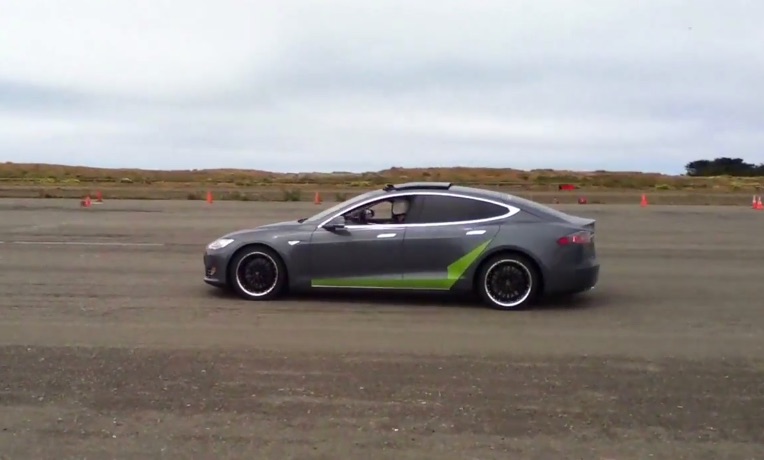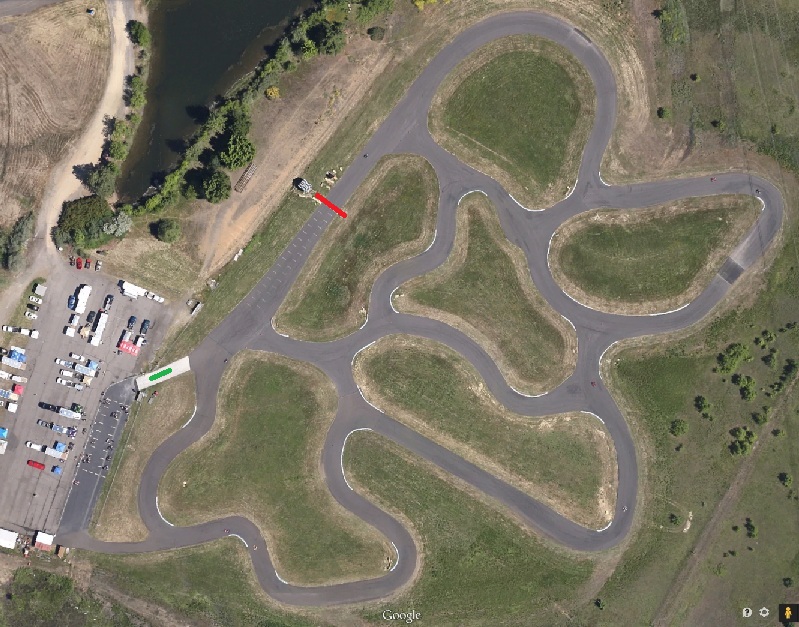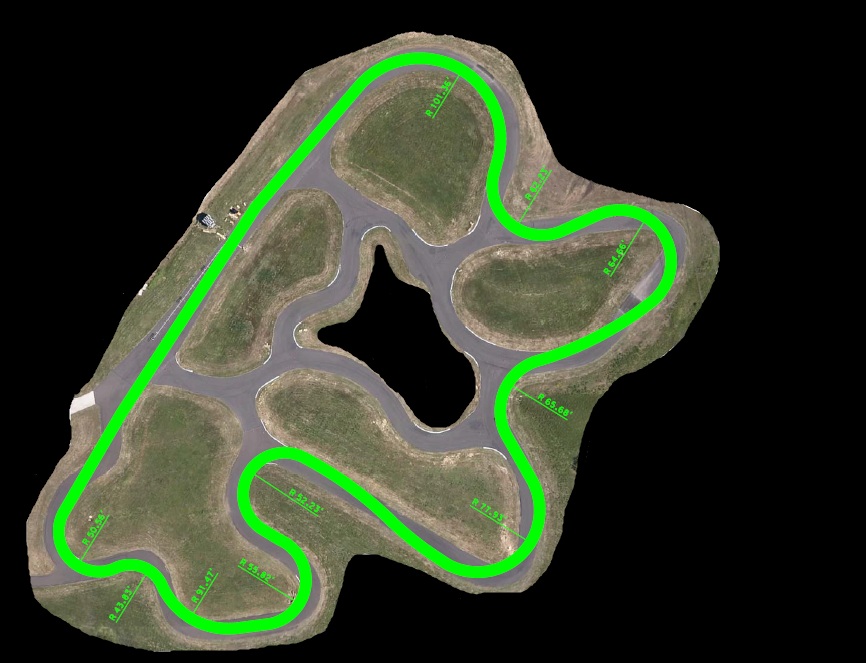Lifestyle
The Ultimate Tesla Model S Autocross Enduro Race

5 laps of pure adrenaline – Tires and brakes cooking, power limiter kicking in – just a final push to the finish line and…breath again!
Enduro racing, when autocross just isn’t enough. How about 5 continuous laps of autocross? Do you want to see when your car starts to overheat the tires go gooey and brakes begin fading? Experience it all in Enduro!
RELATED: Autocross in a Tesla Model S
There have been complaints about power limitation when tracking a Model S. During the typical ~1 min autocross course the car will not become power limited no matter how hard you punish it. The tires just barely get warm and brakes keep tight, no worries about overheating. A 5 lap Enduro is a different beast entirely. Turbos break, hoses rupture, I have seen brakes glowing and smelled the death scents of tortured ICE cars. This is the Kart Track at the Jackson County Sports Park in southern Oregon and the last autocross event of the year put on by the Siskiyou Sports Car Club (SSCC) is the Fall Enduro.
This event is a clockwise 5 lap race around the outside of the track, roughly 3.3 miles total. The ‘grid’ where cars line up to race is near the lower left corner, cars are launched from the green mark and the start/finish line is at the red line. A 2 second penalty is added to your time for toppling a cone (very few out there to worry about) and 10 seconds for putting all 4 wheels in the grass – don’t do that! Racers have the opportunity to practice several laps at a time on Friday and/or Saturday and then just 1 shot at the full 5 lap time trial on Sunday.
The track record for this Fall Enduro event is 3:39.12 set by a TUI formula in the A Modified class, an average of 43.824s per lap and 54mph! My best laps during practice were in the 52.0xxs range but I wasn’t that quick in the race. I drove a different race line from what I had practiced and feel that it was better but I just wasn’t faster (you can watch a set of practice laps here). Earlier this year in the Spring Enduro race I ‘drove’ off of the track once during practice laps so I became a little overly cautious about my braking points during the actual races. With such a heavy car the margin of error is pretty tiny when going from floored at 75mph+ to full brakes and into a turn.
This last fall I managed to break the F Street track record of 4:25.195 by over 2 seconds but then I was ‘ICEd’ by a mere 3/10ths of a second- so close! My local F Street class competition comes from a CTS-V and an M3 . The CTS-V driver has raced for years so I guess I feel ok about ‘letting’ him beat me (technically he was my ‘teacher’ at the race driving school I did, go figure.)
Vehicle Lap1 Lap2 Lap3 Lap4 Lap5 total time
’13 Cadillac CTS-V Coupe 53.146 52.684 52.265 52.502 51.976 4:22.573
’12 Tesla Model S 52.145 52.318 53.033 52.712 52.704 4:22.912
’13 BMW M3 53.393 53.026 53.264 53.400 53.091 4:26.174
During the race I was pushing close to 75 mph on the straight and used 6.5 kWhr at an average rate of 1.99 kWhr/mi. The S didn’t seem to become noticeably power limited until somewhere around the 4th straight. Through the first 3 laps there was enough power that I could spin the wheels on most of the track so keeping just at the edge of slipping and not dropping too much power can be tricky. Power limiting kicked in on the straights for the last 2 laps and the brakes lost a little confidence by the last lap. For these last laps I pretty much just mashed the throttle to the floor on corner exits, surprising how similar my lap times were…think it means I need to do a bit better in the first 3 laps, read:drive smoother and tighter lines! Driving faster isn’t always faster, taking smooth lines without a lot of slop is usually faster but from an observer it may look slow.
Before I headed out to the track I tried sketching a race line and checking turn radii. After practice and speaking with some locals I tweaked my planned line a bit and ended up with something a little different. My goal was to try and hit all of the apex points that I could on the backside, hopefully something like this
Next Siskiyou Sports Car Club event and the first race of 2015 is the SSCC Spring Enduro, Counter clockwise around the wide curve at the top, past the start line then a hard left and right into the lower loop clockwise up the gut and back around to the finish…
See you there!
Lifestyle
Tesla Model S Plaid battles China’s 1500 hp monster Nurburgring monster, with surprising results
There is just something about Tesla’s tuning and refinement that makes raw specs seem not as game-changing.

The Tesla Model S Plaid has been around for some time. Today, it is no longer the world’s quickest four-door electric sedan, nor is it the most powerful. As per a recent video from motoring YouTube channel Carwow, however, it seems like the Model S Plaid is still more than a match for some of its newer and more powerful rivals.
The monster from China
The Xiaomi SU7 Ultra is nothing short of a monster. Just like the Model S Plaid, it features three motors. It also has 1,548 hp and 1,770 Nm of torque. It’s All Wheel Drive and weighs a hefty 2,360 kg. The vehicle, which costs just about the equivalent of £55,000, has been recorded setting an insane 7:04.957 at the Nurburgring, surpassing the previous record held by the Porsche Taycan Turbo GT.
For all intents and purposes, the Model S Plaid looked outgunned in Carwow’s test. The Model S Plaid is no slouch with its three motors that produce 1,020 hp and 1,420 Nm of torque. It’s also a bit lighter at 2,190 kg despite its larger size. However, as the Carwow host pointed out, the Model S Plaid holds a 7:25.231 record in the Nurburgring. Compared to the Xiaomi SU7 Ultra’s record, the Model S Plaid’s lap time is notably slower.
Real-world tests
As could be seen in Carwow’s drag races, however, Tesla’s tech wizardry with the Model S Plaid is still hard to beat. The two vehicles competed in nine races, and the older Model S Plaid actually beat its newer, more powerful counterpart from China several times. At one point in the race, the Xiaomi SU7 Ultra hit its power limit due to its battery’s temperature, but the Model S Plaid was still going strong.
The Model S Plaid was first teased five years ago, in September 2020 during Tesla’s Battery Day. Since then, cars like the Lucid Air Sapphire and the Xiaomi SU7 Ultra have been released, surpassing its specs. But just like the Model Y ended up being the better all-rounder compared to the BYD Sealion 7 and the MG IM6, there is just something about Tesla’s tuning and refinement that makes raw specs seem not as game-changing.
Check out Carwow’s Model S Plaid vs Xiaomi SU7 drag race video below.
Lifestyle
500-mile test proves why Tesla Model Y still humiliates rivals in Europe
On paper, the BYD Sealion 7 and MG IM6 promised standout capabilities against the Model Y.

BYD is seeing a lot of momentum in Europe, so much so that mainstream media has taken every opportunity to argue that the Chinese automaker has beaten Tesla in the region. But while BYD sales this year in Europe are rising and Tesla’s registrations remain challenged, the raw capabilities of vehicles like the Model Y are difficult to deny.
This was highlighted in a 500-mile challenge by What Car? magazine, which showed that the new Tesla Model Y is more efficient, cheaper to run, and more reliable than rivals like the BYD Sealion 7, and even the nearly 400 KW-charging MG IM6.
Range and charging promises
On paper, the BYD Sealion 7 and MG IM6 promised standout capabilities against the Model Y. The Sealion 7 had more estimated range and the IM6 promised significantly faster charging. When faced with real-world conditions, however, it was still the Model Y that proved superior.
During the 500-mile test, the BYD nearly failed to reach a charging stop, arriving with less range than its display projected, as noted in a CarUp report. MG fared better, but its charging speeds never reached its promised nearly-400 kW charging speed. Tesla’s Model Y, by comparison, managed energy calculations precisely and arrived at each stop without issue.
Tesla leads in areas that matter
Charging times from 25% to 80% showed that the MG was the fastest at 17 minutes, while Tesla and BYD were close at 28 and 29 minutes, respectively. Overall efficiency and cost told a different story, however. The Model Y consumed 19.4 kWh per 100 km, compared to 22.2 for MG and 23.9 for BYD. Over the full trip, Tesla’s charging costs totaled just £82 thanks to its supercharger network, far below BYD’s £130 and MG’s £119.
What Car? Magazine’s testers concluded that despite BYD’s rapid sales growth and the MG IM6’s seriously impressive charging speeds, Tesla remains the more compelling real-world choice. The Model Y just offers stability, efficiency, and a proven charging infrastructure through its Supercharging network. And as per the magazine’s hosts, the Model Y is even the cheapest car to own among the three that were tested.
Watch What Car? Magazine’s 500-mile test in the video below.
Lifestyle
Tesla Cybertruck slapped with world’s least intimidating ticket, and it’s pure cringe
One cannot help but cringe and feel second-hand embarrassment at the idea of a person just driving around with a stack of these babies.

A Cybertruck parked at Stanford Shopping Center in California was recently hit with what might be the most try-hard piece of paper ever slipped under a wiper blade: a “fake citation” accusing the driver of supporting a “fascist car.”
The note, shared on X by Tesla staff program manager Ryan Torres, quickly made the rounds on X, where it quickly gained attention as an example of how not to protest.
The world’s least intimidating ticket
According to the citation, the supposed “violation” was “driving a fascist car.” The remedial action? Take the bus, call an Uber, or ride a bike. The note also dubbed Elon Musk a “chainsaw-wielding Nazi billionaire.” Now, protests against Tesla and Elon Musk have become commonplace this year, but one cannot help but cringe and feel second-hand embarrassment at the idea of a person just driving around with a stack of fake anti-Tesla/Musk citations.
Torres pointed out the irony himself in his post on X. Tesla currently employs over 140,000 Americans, and SpaceX has put the U.S. firmly back at the top of space technology. As Torres put it, maybe the person behind the world’s least intimidating ticket should “read a book on innovation before vandalizing” other people’s property.
Peak performative clownery
Not to mention that the fake ticket’s logic collapses under its own weight. EVs like the Cybertruck are literally designed to reduce emissions, not “destroy the economy.” If anything, Tesla has bolstered the United States’ economy by fueling jobs in engineering, manufacturing, and clean energy. It’s not the first time a Tesla has been the target of vandalism or politically charged notes, but this one stands out for sheer cringe value.
Torres summed it up neatly: “Peak clownery.” On that point, at least, the citation earns full marks. In a way, though, perhaps cringe fake tickets are not as bad as the literal firebombs that were being thrown at Tesla stores and cars earlier this year because some critics were gleefully misinformed about Elon Musk.
-

 Elon Musk2 weeks ago
Elon Musk2 weeks agoSpaceX posts Starship booster feat that’s so nutty, it doesn’t even look real
-

 Elon Musk2 weeks ago
Elon Musk2 weeks agoTesla Full Self-Driving gets an offer to be insured for ‘almost free’
-

 News2 weeks ago
News2 weeks agoElon Musk confirms Tesla FSD V14.2 will see widespread rollout
-

 News2 weeks ago
News2 weeks agoTesla is adding an interesting feature to its centerscreen in a coming update
-

 News2 weeks ago
News2 weeks agoTesla launches new interior option for Model Y
-

 News2 weeks ago
News2 weeks agoTesla widens rollout of new Full Self-Driving suite to more owners
-

 Elon Musk2 weeks ago
Elon Musk2 weeks agoTesla CEO Elon Musk’s $1 trillion pay package hits first adversity from proxy firm
-

 News1 week ago
News1 week agoTesla might be doing away with a long-included feature with its vehicles









